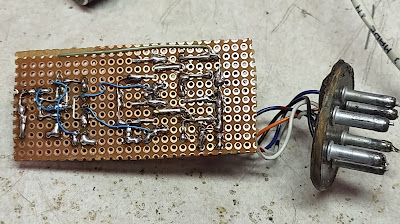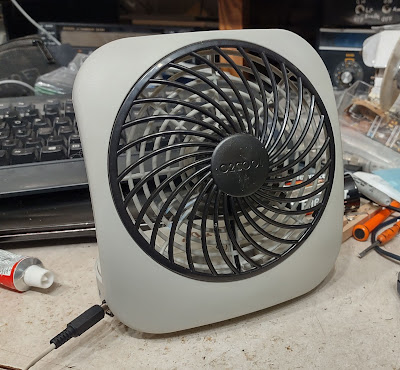 |
| Figure 1: The front of the Wards Airline 62-345 with its rather distinctive "telephone dial" tuning dial. It's powered up and running from 12 volts! Click on the image for a larger version. |
How high voltage was made from low voltage DC in the 30's
As the technology of the time dictated, this radio has what's called a "vibrator" inside - essentially a glorified buzzer - that is used as a voltage chopper along with a transformer to convert the 6 volts from the battery to the 130-150 volts needed for the plates of the tubes within. Not only did this vibrator do the chopping for the high voltage, but it also performed the duty of synchronously rectifying the AC waveform from the transformer as the pulses from it would naturally be in sync with the motion of the moving reed, briefly connecting the output of the transformer to the input of the high voltage DC supply when the voltage waveform from it was at the correct polarity.
These devices, as you would expect, don't have a particularly long lifetime as they are constantly buzzing, making and breaking electrical contact and causing a small bit of arcing - something that will inevitably wear them out. Even if the contacts were in good shape, the many decades of time that have passed will surely cause these contacts to become oxidized - particularly since these devices are in rubber-sealed cans (to minimize noise and vibration) and the out-gassing of these materials is likely of no help in their preservation.
 |
| Figure 2: The chassis of the radio. The vibrator is in its original can in the far right corner. Click on the image for a larger version. |
The solid-state replacement
As mentioned earlier, the job of the vibrator was to produce a chopped DC waveform, apply it to a transformer for "upping" the voltage and then use a separate set of contacts to perform synchronous rectification - and our solid-state replacement would need to do just that. That last part - rectification - was easy: Just two, modern diodes would do the job - but chopping the DC would require a bit more circuitry.
The owner of this radio also had a few other things in mind: He changed it from 6 volts, positive ground to 12 volts, negative ground so that it could be readily operated from this more-common power scheme. The change to 12 volt filaments required a bit of work, but since all of the tubes were indirectly heated, the filament supply could be rearranged - but some tubes had to be changed to accommodate different filament voltages and currents as follows:
- Oscillator and detector: This was originally a 6D8 (6.3v @ 150mA) and it was replaced with a 6A8 (6.3V @ 300mA). Other than filament current, these tubes are more or less the same.
- IF Amplifier: The original 6S7 (6.3v @ 150mA) was retained.
- 2nd Detector/AVC/1st Audio: The original 6T7 (6.3V @ 150mA) was retained.
- AF Output: The original 1F5 (2.0v @ 150mA) was replaced with a 6K6 (6.3v @ 400mA). The latter is a pentode, requiring a bit of rewiring and rebiasing to replace the original triode.
- Magic Eye tube: The original 6N5 (6.3v @ 150mA) was replaced with a 6E5 (6.3v @ 300ma) - which is also more sensitive than the 6N5, giving a bit more deflection.
The 6T7 (150mA), 6A8 (300mA) and the #47 dial lamp (6.3v @ 150mA) are wired in parallel on the low side with one end of the filament grounded while the 6K6 (400mA), 6S7 (150mA) and 6E5 (300mA) are wired in parallel on the high side with one end of the filament connected to +12 volts. You might notice a current imbalance here (600mA on the low side with 850mA on the high side) but this is taken care of with the addition of 30 ohms of resistance between the midpoint of the filament string and ground to sink about 200mA, getting us "close enough".
He also did some additional rebiasing and other minor modifications - particularly for the rewiring of the AF Output from the original 1F5 to a 6K6 as he swapped a triode for a pentode - which was then wired as a triode. The total current consumption of the radio at 13 volts is 1.6 amps - a bit more than half of that being the filament and pilot lamp circuits meaning that about 10 watts of power is being used/converted by the vibrator supply and consumed by the idle current of the audio output and other tubes.
The "chopper" circuit
The other issue with the 6 to 12 volt conversion is that of the primary of the high voltage transformer: This transformer is center-tapped with that connection going to the "hot" side of the battery (which was originally at -6 volts) - but what this really means is that there's about 12 volts from end-to-end on the transformer at any instant. We can deal with this difference simply by driving the transformer differently: Rather than having the center tap "hot" with the DC voltage and alternatively grounding one end or the other as the vibrator did we can simply disconnect the transformer's center tap altogether and alternately apply 12 volts to either end, reversing the connection electronically to preserve the original voltage ratio between primary and secondary.
This feat is done using an "H" bridge - an array of four transistors that will do just what we need when driven properly: Apply 12 volts to one side and ground the other - or flip that around, reversing the polarity.
Consider the schematic below:
This diagram shows a fairly simple circuit. For the oscillator we are using the venerable CD4011 quad CMOS NAND gate with the first two sections wired to produce a square wave with a frequency somewhere in the 90-150 Hz region - the precise value not being at all critical. The other two sections (U1c and U1d) take the square wave and produce two versions, inverted from each other.
 |
| Figure 4: The top (component side) of the circuit. This is built on a piece of phenolic prototype board. Click on the image for a larger version. |
- Let us say that the output of U1c is high. This causes the output of U1d to be low as it's wired as a logic inverter.
- The output of U1c being high will cause the top transistor (Q1 - a PNP Darlington) to be turned OFF, but at the same time the bottom transistor of this pair, Q2, will be turned ON, causing the connection marked "PIN 1" to be grounded.
- At the output of U1d - being low - we see that the bottom of this pair of transistors, Q4, is turned OFF, but the top transistor Q3 is turned ON causing V+ (12 volts) to appear at the connection marked "PIN 5".
- In this way, the low-voltage primary of the transformer has 12 volts across it.
- A moment later - because of the oscillator - the output of U1c goes low: This turns off Q2 and turns on Q1 - and since this also causes the output of U1d to go high this, in turn, turns off Q4 and turns on Q3. All of this causes "PIN 5" to now be grounded and "PIN 1" to be connected to V+ - thus applying the full 12 volts to the transformer in reverse polarity.
Now some of you might be concerned about "shoot through" - the phenomenon when both the "upper" transistors (Q1, Q3) might be on - if only for an instant - at the same time as the "lower" transistors (Q2, Q4) as the switching is done. While this may happen to a small extent, it has negligible effect - particularly at the low switching frequency where this effect would constitute a very minuscule percentage of the switching period: This circuit is efficient enough that no heat sinking is required on transistors Q1-Q4 and they get only barely warm at all. Were I to build it again I might consider ways to minimize shoot-through, but this would come at the expense of simplicity which, itself, is a virtue - and since this circuit works just fine, would probably be not worth the effort.
 |
| Figure 5: The bottom (wired side) of the circuit with flying leads connecting to the original base socket. Click on the image for a larger version. |
These days one might consider building this same type of circuit using MOSFETs instead of Darlington transistors (e.g. P-channel for Q1 and Q3, N-channel for Q2 and Q4) and this should work fine - but the Darlington transistors were on hand at the time that this circuit was built and very easily driven by U1 - and the bipolar transistors are - at least in this case - arguably more rugged than the MOSFETs would be - particularly since there was no need to include a "snubber" network to suppress switching transients that might occur. It's also worth noting that while standard MOSFET transistors would work fine for a 12 volt supply, you'd have to be sure to select "low gate threshold" devices to work efficiently at 6 volts or lower - something that would not really be an issue with the bipolar Darling transistors shown here.
This circuit is simple enough that it was wired onto a piece of phenolic prototyping board, snapped down to a size that will nicely fit into the original can that housed the vibrator. To complete the construction, the top of the can - which was originally removed by careful filing and prying - was glued into its base using "shoe goo" - a rubber adhesive - keeping the board protected, but also allowing it to be easily disassembled in the future should modification/repair be necessary.
To be sure, the Internet is lousy with this same sort of circuit, but this version has worked very well.
What about the center tap version of the solid state vibrator?
You might ask yourself "what if we don't want to rewire a 6 volt radio to 12 volts?" As noted previously, the boost transformer in the radio had its center tap connected to the "hot" side - which, in this case, would have been the negative terminal (because many vehicles had 6 volt, positive grounds at the time). This circuit could be easily modified for that as you'd need only "half" an "H" bridge and the resistors driving the transistors would be changed to a lower value - perhaps 2.2k. Depending on whether the it was positive-ground or negative ground, or whether the center-tap was grounded or "hot" - this would dictate whether you needed the PNP or NPN halves of the H-bridge.
(If you have a specific need, feel free to contact me by leaving a comment.)
* * *
This page stolen from ka7oei.blogspot.com
[END]









